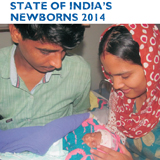
The decade since the publication of the first report on the State of India’s Newborn in 2004 (SOIN 2004) has witnessed momentous changes in the neonatal health scenario in India. With the launch of the National Rural Health Mission (NRHM) in 2005, newborn healthcare has received unprecedented attention and resources.
The 2014 State of India’s Newborns report captures the story of country’s neonatal health initiatives in recent years. It is an honest effort to share the experience of the country in improving neonatal health with a wide spectrum of national and global stakeholders. It celebrates the success but also provides insights to address the gaps. Above all, it intends to ignite aspiration and hope for attaining the best possible neonatal health status in the country in near future and the long term.
The mid- 2014 is an exciting phase in India’s history. A new government has taken over at the Centre with the promise of good governance and efficient delivery; a government that aims at radical reforms of the healthcare system. There is an overwhelming sentiment of hope and of high expectations from the health sector.
It is an apt moment to reflect on the progress in improving newborn and child health which is at the centre of country’s development agenda. It is also time to outline medium and long term vision and strategies to attain the best possible survival and health of children of India in near future.
The national government is committed to a National Health Assurance Mission that ensures accessible, affordable and effective universal healthcare. Maternal, newborn and child healthcare would be at the core of this Mission. We need to make sure that no woman, no neonate and no child should be left behind as the country surges ahead in development and welfare. Inequity, whether geographic, or of class or gender, is unacceptable.
Removing inequities would require addressing the key social determinants, mounting a behaviour change movement on scale and ensuring access to quality services by every mother, every baby in every part of the country. The goal of averting every preventable newborn death, and stillbirth, would require not only further acceleration of present initiatives, but also implementation of new approaches and programmatic innovations.
India’s academia and industry need to develop affordable products and solutions for maternal, newborn and child care that are applicable worldwide. Indian researchers need to explore the poorly understood science of prematurity, fetal growth restriction, and brain development.
Newborns should not only survive, but also thrive and attain the highest developmental potential. This mandates that we track and take care of every child beyond survival for growth, nutrition, health and development.
India is committed to the attainment of MDG 4 which is within its reach with accelerated newborn and child survival action in the coming months. The XII Plan goal of IMR of 25 by 2017 would require NMR to be around 18 per 1000 live births.
The Every Newborn Action Plan (ENAP) that has been recently endorsed by the World Health Assembly calls for an NMR of less than 10 per 1000 live births by 2035 in all countries. This is in line with the imperatives of the goal of U5MR of 20 or less by 2035 set in the ‘Committing to Child Survival: A promise renewed’ initiative that India cohosts. India has the potential to achieve the 2035 goals much earlier. But translating such aspirations into deliverables would require long term view, executional brilliance, intersectoral synergy and, above all, political resolve. The India Newborn Action Plan (INAP) being launched by the Government of India indeed incorporates these very principles. A step in the right direction, the Plan effectively sets the stage for an acceleration in neonatal survival and health.